Interview of Marshall Burns
Transcript of interview by Hermes Moore, chief editor of 3D Printing Industry on May 26, 2016, liberally edited and augmented.
Q. Most people think 3D printing is something new. But you’ve got models here made on 3D printers 25 years ago, along with books about the technology from that long ago. How did you come to have all this stuff?
In 1991, I was finishing work on my PhD in physics at the University of Texas at Austin. One day, I saw a presentation about a company started by the Mechanical Engineering Department. The company was called DTM Corporation, which stood for “DeskTop Manufacturing.” They showed a video of a machine that used three-dimensional computer data to scan a laser over a box of powder to make an actual physical object described by the data. My jaw dropped to the floor and I thought, “This is what I came here for. This is what I’m going to use my PhD to work on.”
Mechanical engineering was in the next building over from physics. So I went next door and met Carl Deckard and Joe Beaman, who had developed this process they called “Selective Laser Sintering.” I then spent the next three weeks in the library (this was before the Internet!) learning everything I could about similar technologies. I found out about 3D Systems, which had been in business and selling machines for a couple of years by that time, and other startups, like Stratasys and Helisys. When I finished my PhD in May, I set out on a driving trip around the United States, meeting everyone I could who was doing work on this technology. I met with Scott Crump at Stratasys and Efrim Fudim at Light Sculpting. I went to Detroit and met the automotive engineers using Stereolithography to prototype car parts. I visited MIT (where I had earned my undergrad degree 15 years earlier) and met Ely Sachs, who was developing what they called at that time “3D Printing.” That was a process that was later licensed by Z Corporation, which is now owned by 3D Systems. Many of the models in my collection are from Z Corporation.
So how the collection came about is that as I traveled around, I asked people, “Can I have a sample of what your machine makes?” At one time, the collection was much, much larger. What remains today is a selection of the most interesting examples from those early days of digital fabrication.
After that trip, I continued my education by attending conferences, both in the US and overseas, and by reading everything that was written about the technology. Again, there was no Internet in those days, so reading materials came on paper. That’s where the “Industry Library” section of the collection comes from.
Q. What are the most interesting items in the collection?
The collection is organized into five sections. I think most people will be most interested in the first two sections, the Fabricated Artifacts and the Industry Library.
In Section 1, “Fabricated Artifacts,” there are a lot of really interesting items.
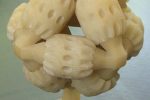
The gear tree was the most astounding object, I think, ever made on a 3D printer. It’s a mechanism; it has moving parts that are interlinked, that never existed apart from each other. Today, many machines can make that routinely, but in 1991, it was mind-blowing. That’s why there are two of those in the collection, because they were just astounding.
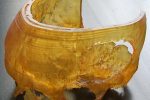
When a team of surgeons have a patient on the operating table with a broken bone, it’s covered by skin and they don’t know what they will be facing when they go inside. So they cut open the skin and the first thing they do is look around to figure out what the person’s injury is like.
The fractured skull in the collection is a model of a real patient who had sustained a skull injury, a fracture to his skull. The surgeons at UCLA Medical Center who were going to operate on him used CT data, essentially a 3D X-ray, of the man’s skull to have a plastic model made of it by Stereolithography. This told them what they would be dealing with before they took scalpel to skin. They knew where the bone was broken and they were able to design a plate in advance to mend the fracture. This revolutionary, new technique was tremendously valuable. It saved the surgeons many hours in the operating room, thus reducing the trauma of the surgery on both the patient and his insurance company. The model shows where the bone of the skull was fractured, so you see exactly what the surgeons learned by studying the model.

A young man had lost his left ear to a cancer operation. The University of Illinois digitized the shape of his right ear and the data were flipped to fabricate a mirror-image left ear model by Stereolithography. This model was used as a pattern to mold a rubber prosthesis that was affixed firmly on the side of the man’s head. The patient even enjoyed water-skiing with his new ear.
A human ear is very difficult to reproduce, except with computer data. To get it exactly the same as the opposite ear, so the person’s face is symmetrical, is extremely difficult to do without a computerized process.
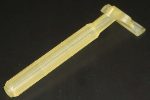
This prototype of a new design for a Gillette disposable razor was made in two parts. One part is the handle and the other is the head that does the shaving. The two parts were assembled by snap-fitting, in other words by pressing them together so that a clip on the head stretched slightly to grab onto a bracket on the handle.
The earliest models made by Stereolithography were very brittle; they were prone to breaking with the slightest touch. This razor model demonstrated a new material with the resiliency to endure the stretching of a snap-fit, which was an important breakthrough in material properties.
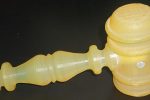
Another breakthrough was materials that were tough and machinable, meaning they could undergo cutting operations, such as drilling, without breaking apart.
Like the razor, the gavel was made in two parts, the handle and the head. But instead of snap-fitting, the gavel was assembled by inserting one end of the handle into a cavity in the head. A hole was drilled into one side of the head, through the end of the handle, and out into the other side of the head. Then, the far side of the head was tapped, meaning that a thread was cut into the hole, allowing a screw to grip onto it. Finally, a screw was inserted into the hole and screwed into the threads to hold the gavel together solidly. An executive from 3D Systems demonstrated this new, tough material by banging this gavel loudly on the podium at the 1991 Dayton Conference.
The ability to drill and tap fabricated parts that could be assembled into a strong, solid product was a tremendous breakthrough.
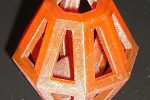
A company called Quadrax made a machine called the Mark 1000, which was similar to the Stereolithography machine made by 3D Systems. A lawsuit for patent infringement was settled by Quadrax taking its product off the market. During its short life, the Mark 1000 was used to make this intriguing ball in a cage, the first demonstration of fabricating a combination of multiple, interlocked parts without assembly. This was the same capability that was later taken to a much higher level by Cubital in its gear tree.
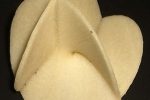
There were some people who, early on, started using this technology for what we can call digital sculpture. They made artwork using these machines. One of the first to do that was Stewart Dickson, a digital artist who makes art from mathematical equations. There are two different sculptures by him in the collection. The earliest one is called “Enneper’s surface,” a mathematical term for a set of equations that define the three-dimensional shape of this object. It was made in the DTM Sinterstation using the process of Selective Laser Sintering.
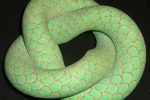
The other Dickson digital sculpture is again based on mathematical equations that define its shape. Because it looks like a snake chasing its tail, a kind of a serpentine shape that connects back to itself, Dickson put a snakeskin texture on the data. Then, because he was working with a “Z” machine, the first fabricator capable of making objects in full color, he also colored the skin so that it looks like the skin of a snake. Like the gear tree, I found this sculpture so remarkable that there are two of them in the collection.

DuPont, the chemicals giant, developed a selective curing technology that it licensed to a small company called Aaroflex. It also was very creative in developing new materials for use in the 3D Systems SLA. The collection includes two “tensile bars” made from the first flexible material and the first translucent material available for digital fabrication.
A tensile bar is an object made from any material for the purpose of testing how strong it is. The “tensile strength” of a material means how far it can be stretched before it breaks. A tensile bar is made with the shape to fit in a machine designed for testing tensile strength. You clamp the two ends of the bar into the machine, which then pulls it apart, keeping track of how much force it’s applying. This allows you to see how much force it takes before the item breaks.
With the flexible tensile bar, you can hold it in your hands and bend it to experience directly how flexible the material is. This was another important breakthrough in material properties for digital fabrication.
Section 2 of the collection, the “Industry Library,” will mostly be of interest to a library that would like to have a complete collection of books and periodicals about 3D printers from the 1990s. This section includes every book published on this subject anywhere in the world up through the mid-1990s, plus some of the most important early books after that. It includes the proceedings of every English-language conference held on the subject anywhere in the world up through the late 1990s, plus two in Japanese. And it includes a complete set of all 129 print issues of the Rapid Prototyping Report until the newsletter went online-only in 2002. The Industry Library also includes some especially interesting items.

In addition to books and other public documents, the Ennex files also included the confidential reports produced for our consulting clients, which included small technology start-ups as well as some of the largest companies in the world, such as Dow Chemical, Rockwell International, and the German chemical giant, Huls AG. It occurred to me to ask these clients if they would allow their reports to become part of this historical collection, and several agreed to this.
These reports provide a unique glimpse into how people were thinking about exploiting opportunities with this technology in the 1990s or improving the technology and its utilization.

In 1998, Ennex assembled a Board of Customers to provide feedback on its confidential plans for development of a new 3D printer technology. The board included representatives of Disney, Mattel, Sandia National Laboratory, and other companies. Two meetings were held, in which members of the board spoke frankly about their needs and wants for the technology. The video recordings of these meetings offer a unique look into the perspectives of early adopters of the technology.
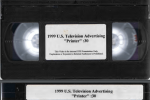
In 1999, United Parcel Service (UPS) aired a television advertisement that dramatically illustrated a future world with products delivered by 3D printers. I wrote two articles about this amazing TV ad, UPS Foretells the Fabber Revolution in Rapid Prototyping Report, December 1999 and Fabbers and the Internet in Zone News, January 2000.
As part of my research for those articles, I contacted UPS and obtained from them a copy of the ad on a VHS cassette, which is included in the Industry Library section of the collection.
Section 3, “Ennex Library” might be of interest for a view of a company attempting to launch a new 3D printer technology in the late 1990s. One particularly interesting item in this section is:
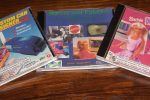
In 1998, Ennex made a presentation to Doug Glen, senior vice president of toy manufacturer Mattel. The presentation included mockups of two proposed new products for Mattel, Barbie Designer and Custom Car Designer.
Q. What was your intention when you asked people for samples of objects made on their machines? Was it just for fun, or did you know you were growing a collection?
I wasn’t growing a collection, I was growing a business. I was on a mission to become the world’s foremost expert on this technology. It was the most natural thing in the world to have a lot of examples of what it was that I was aiming to be an expert about.
I used the samples to explain the concept of digital fabrication in public presentations and in consulting meetings. In the photograph of the artifacts section of the collection, you can see two briefcases that I made to carry with me on business trips for these presentations and meetings.
Q. Did you achieve your goal and become that expert?
There were certainly other people who knew as much about the technology as I did. And yes, I would say I achieved a healthy standing among them.
The primary experts were the inventors who created the industry. These are the people who deserve the most credit in this field, such as Chuck Hull at 3D System, Scott Crump at Stratasys, Carl Deckard and Joe Beaman at the University of Texas and DTM, Michael Feygin at Helisys, Ely Sachs at MIT, Marina Hatsopoulos at Z Corporation, Phill Dickens at the University of Nottingham, and many other like them.
Another leading expert was Terry Wohlers, an independent consultant who was well known in the industry before I came along. He was someone I admired and respected and learned from. He published a report every year called the Wohlers Report that was an important publication in the field.
My main claim to fame was the book Automated Fabrication, published by Prentice Hall in 1993. (Now available free online for the first time: AutofabBook.pdf) It was the first major book on the technology and for a long time was the primary reference on it. I also wrote a lot of articles for the Rapid Prototyping Report. As I became known in the industry, I began to be invited to give talks all over the world. I was the keynote speaker at the Stereolithography Users Group Meeting in San Francisco in 1992 and later that year at the First European Conference on Rapid Prototyping in Nottingham. The United Nations asked me to speak at a conference on sustainable development in Nigeria, Africa in 1994. Other keynotes I gave were at the annual meeting of the Association of Professional Model Makers in Milwaukee, Wisconsin in 1995, the Rapid Prototyping Symposium in Kyoto, Japan in 1996, the IEEE Symposium in Guimaraes, Portugal in 1997, and TCT 2000 in Cardiff, Wales in 2000.
In 2007, long after I’d moved on to other work, I was voted one of the 25 most influential people in the industry
Q. If you were doing so well in this field, why did you move on, and what did you do then?
Although I did very well as a consultant and industry expert, what I really wanted to do was develop new technologies. I didn’t want to just talk about digital fabrication, I wanted to create machines that did it. In the mid-1990s, I tried to leverage my reputation in the field to transition Ennex to become a manufacturer of fabricators, or what are today called 3D printers. Unfortunately, this gambit did not work. As I focused more on raising money for development of new technology, the revenue from consulting declined. I built a team of five dedicated engineers who worked for future stock options and we built two generations of prototypes of the proposed new product, called the Genie Studio Fabricator. We got a small seed investment from a venture capital firm, but did not succeed in advancing that to additional rounds of funding. By the end of the 1990s, I was exhausted and Ennex was out of money.
In the early 2000s, I had a few jobs in high tech, including teaching a course on digital manufacturing at the University of Southern California (USC). But I also spent a lot of time looking around at the world, and eventually found my interests shifting from technology to human issues. In 2007, I spent five months on a trip to Africa and India and turned the focus of my work to issues in social justice.
Q. Do you think about getting back into this field now that it’s become much more popular than when you were involved?
No. My work on digital fabrication in the 1990s was an exciting career. I’m proud of the contribution I made and I’m grateful for the opportunity I had to work with amazing people on amazing projects, and to travel all over the world in the process. Today, I apply my experience as a scientist and a businessman to understanding issues of social justice and I’m looking forward to making new breakthroughs in that domain. In the meantime, I’m excited to see a new generation of inventors and entrepreneurs carrying forward on what they now call 3D printers. I just hope the human species will survive long enough to enjoy the fruits of their work!
Q. Have you kept up your relationships with people in the industry?
I’ve kept in touch with a few people and we’ve recently marveled at how the technology is finally coming into worldwide awareness. One of the exciting things about putting this collection together is that it became an occasion to get back in touch with some other old friends that I hadn’t talked with in 20 years.
Q. How did you get the idea to put the collection up for auction?
I knew I had these things in storage for decades now, but I didn’t really understand the extent of what I had until I started going through it all. I thought I had a couple of boxes of old models and books, but when I went through it, there were 13 boxes and two briefcases. There were models made on 20 different machines. There were dozens of vendor video tapes. There were newsletters, magazines, consulting reports, business plans, and even experimental results. It occurred to me that, now that 3D printing has become well-known, there might be an appreciation for the historical background these materials provide of the technology.
I decided to make a careful inventory, taking pictures of all the items and scanning the tables of contents of all the books and periodicals. When I finished that, I was astounded by what I had. It seemed that there are probably some libraries or museums that would be interested in having these materials.
The collection is completely unique; there is no set of comparable materials available to check for a valuation. So it seemed that the best way to find it a new home is by auction. Hopefully, an institution with the ability to purchase the collection will also have the resources to properly curate it and make it available to the public and interested scholars for study.
Q. Do you know how much money you expect to get from the auction?
I really don’t. I imagine that the places interested in buying the collection will be museums and libraries or possibly a company that wants to establish a historical industry museum and library. I’ve never worked with museums or libraries before and I have no idea what value they would put on a collection like this to add to their own.
What value would you put on an original gear tree from 1991 or a fractured skull model from 1994? Or on a complete set of proceedings of all the English-language conferences on 3D printing from the 1990s? Or on all the issues of the Rapid Prototyping Report that were ever printed? Or on a set of previously confidential consulting reports showing what Dow Chemical, AlliedSignal, and Huls AG were thinking about this technology in the 1990s?
Is it worth $100? Probably more than that. Is it worth 100,000? Probably less than that. I figured the only way to find out is to have an auction and let people bid on it.
I hope I don’t have to run the auction myself on eBay because I don’t know anything about running auctions. I’ve been contacting auction houses and asking if they would be interested in including this collection in one of their auctions. Many of them have got back to me and said they don’t have the expertise or the market for such a collection, and I understand that. But I’m hoping there will be an auction house that deals with technical relics that understands these materials.
Making money is not the most important thing for me. If it turns out that there is no market to purchase the collection, I’ll be happy to donate it to a museum and/or library that would like to have it. But if it does have a monetary value, it would be nice to be compensated for the blood, sweat, and tears that went into assembling the collection.
Q. Why are there so many artifacts from November 1991?
On the webpage for Section 1 of the collection, “Fabricated Artifacts,” the artifacts are sorted in order of date, either the date the object was made or the date I obtained it. The first one, the gavel, is from June 1991 and the ear prosthesis is from August ’91. The next 21 objects are dated “about November 1991.”
I finished my PhD in May 1991 and then went on the road to meet people working with this technology. One of the most important stops that I made on that trip was to the AutoFact trade show put on by the Society of Manufacturing Engineers (SME). “AutoFact” stands for “automated factory” and this was the world’s largest trade show about factory automation. They had CNC machines, robots, automated measuring devices, and all kinds of equipment for factory automation. In the early days, before 3D printing was big enough to have its own trade shows, AutoFact was the big trade show where 3D printer manufacturers went to show off what they were doing. It was held in Detroit in November of each year.
1991 was the year that I started, so in November of 1991, when I was driving around the United States, I made sure that I was in Detroit in November so that I could go to AutoFact. And that’s where I started to get a lot of the models in this collection. I would talk with the people at the show, tell them I’m doing research on this technology, and ask for samples to take with me.
Excluded content from the transcript
After that trip around the US in 1991, I settled down in Los Angeles and started Ennex Fabrication Technologies with the objective to do consulting on this technology. In 1993, I wrote a book, Automated Fabrication, the first major book on this subject, published by Prentice Hall, a major technical publisher.
At the same time that I put up the website about this collection, I also for the first time made that book freely available online (AutofabBook.pdf). That book gives you a vantage point, from 23 years ago, of what the state of the art and the history of the technology was back then.
Photographs of several of the artifacts in the collection are also in the book, for example, the gear tree by Cubital, the leg prosthesis socket by Joshua Rovick at Northwestern University, and the ear prosthesis by Ray Evenhouse at the University of Illinois.
Most of the conference proceedings in the collection are the proceedings of conferences that I went to, and in many cases, spoke at. That’s why I had the proceedings. I wasn’t thinking at the time of building this historical library. I just went to all these conferences and kept the proceedings from them.
Also, since I wrote this book on the subject, every time somebody else wrote a book about it, I of course had to read it. So I got a copy of every book that was published.
The Rapid Prototyping Report was the primary newsletter of the industry at that time. I got to know the people who published it and I ended up writing quite a number of articles for them. But also, I kept a copy of every issue that they published. As someone who set myself up to be an expert on this technology, it was the most natural thing in the world to keep a copy of everything that was ever published about it.
And I did that for all of the 1990s and into the early 2000s.
Round about the early 2000s, my business was starting to move in another direction and I stopped being so heavily involved in this technology. But I kept all of the models and books that I’d accumulated over the years, and that’s where the collection comes from.
In those days, the technology was called “rapid prototyping.” I rebelled against that terminology. I said, “This is not about prototyping. This is about making things.” A lot of people were upset with me about that.
For question about the auction contact Aurora
All the pictures included in this article are copyrighted by Ennex.com



